新科普版八年级英语上册《2 Howcan we protect ourselves from the earthquake. Section C》优质课教案_4
- 格式:docx
- 大小:68.27 KB
- 文档页数:7

UNIT 4 Our WorldTOPIC 2 How can we protect ourselves from theearthquake?Section A教案ⅠTeaching aims:1. Students learn how to ask others to choose something better how to choose. Use this sentence structure:---Which one do you want, the long one or the short one?---The long one, please.How can we protect ourselves from the earthquake?We can …2. Learn some new words.3. Revise some words, such as: earthquake, dangerous, strive, province etc.3. Try to read a story.4. Learn an English chant.ⅡTeaching methods:Reading / Listening / Talking / Singing / Play GamesⅢTeaching aids:Computer / TV / a tape recorder / brushⅣMain points and difficulties:New wordsExpressions and sentencesⅤTeaching steps:Step 1 Warm-up1. Greetings between the teacher and the students.2. Show the word cards which have been learned in the last class, let students read them quickly. Step 2 Presentation1. Teacher shows the students a map of Sichuan province, and asks them what it is. Then let students say their different points. Yes, This is Sichuan province. Then lead to read the word, province.2. This time teacher shows a picture of rock and a picture of pillow, and also asks them what it is, and if there is anything different between these two things, maybe the students will say one is hard and the other one is soft in Chinese, then the teacher writes these two words on the blackboard, hard and soft, and teach them how to pronounce these two words.3. Then teacher writes the word earthquake, lets students find the word related to this word, and after the students say out the word, teacher writes the word on the blackboard.4. This time, teacher asks the students to find some adjective to describe the earthquake, and write them on the blackboard. And at last, asks the students to copy them down on their own notebook, and read them out loudly.5. Teacher plays the tape of text, lets students try to understand its meaning, and then read after it.7. Then read the text again, and finish the questionnaires.Step 3 Consolidation1. Give the students three minutes to practice the conversation by themselves, then ask some pairs of students to act their dialogue in the class.2. Find some pairs of new words.3. Ask the students to find more new words to describe the earthquake.4. Play the tape again, this time ask the students to imitate after the tape.5. Finish the exercises in Part E, and then correct the answers in the class.Step 3 Consolidation1. Learn to say the chant in Part F.2. Do the exercises in the Workbook.3. Have a dictation.4. Listen to the tape and read it, try to understand the short essay and imitate the pronunciation and intonation.5. Let’s have fun.Homework1. Read the words and sentences of this Unit.2. Do some exercises in exercise books.。
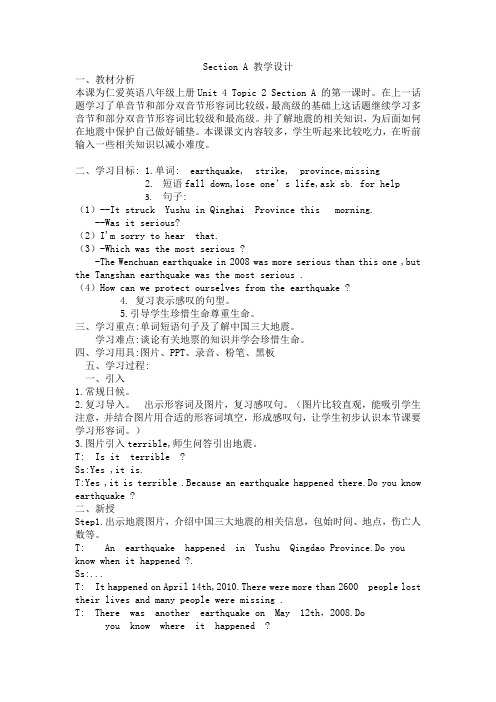
Section A 教学设计一、教材分析本课为仁爱英语八年级上册Unit 4 Topic 2 Section A 的第一课时。
在上一话题学习了单音节和部分双音节形容词比较级,最高级的基础上这话题继续学习多音节和部分双音节形容词比较级和最高级。
并了解地震的相关知识,为后面如何在地震中保护自己做好铺垫。
本课课文内容较多,学生听起来比较吃力,在听前输入一些相关知识以减小难度。
二、学习目标: 1.单词: earthquake, strike, province,missing2.短语fall down,lose one’s life,ask sb. for help3.句子:(1)--It struck Yushu in Qinghai Province this morning.--Was it serious?(2)I'm sorry to hear that.(3)-Which was the most serious ?-The Wenchuan earthquake in 2008 was more serious than this one ,but the Tangshan earthquake was the most serious .(4)How can we protect ourselves from the earthquake ?4. 复习表示感叹的句型。
5.引导学生珍惜生命尊重生命。
三、学习重点:单词短语句子及了解中国三大地震。
学习难点:谈论有关地票的知识并学会珍惜生命。
四、学习用具:图片、PPT、录音、粉笔、黑板五、学习过程:一、引入1.常规日候。
2.复习导入。
出示形容词及图片,复习感叹句。
(图片比较直观,能吸引学生注意,并结合图片用合适的形容词填空,形成感叹句,让学生初步认识本节课要学习形容词。
)3.图片引入terrible,师生问答引出地震。
T: Is it terrible ?Ss:Yes ,it is.T:Yes ,it is terrible .Because an earthquake happened there.Do you know earthquake ?二、新授Step1.出示地震图片,介绍中国三大地震的相关信息,包始时间、地点,伤亡人数等。
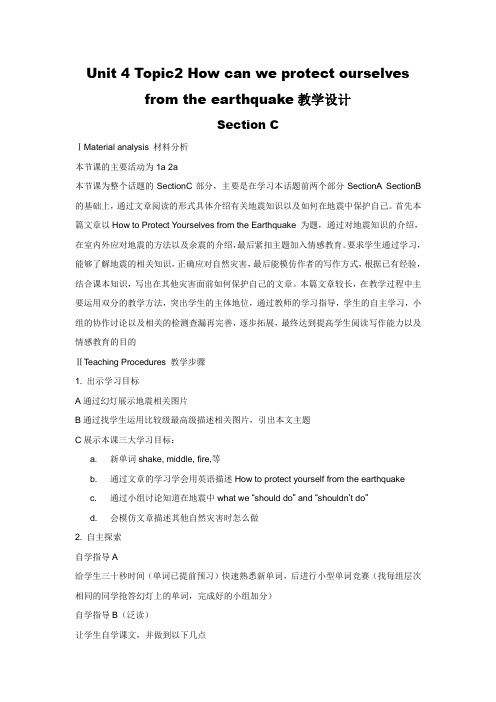
Unit 4 Topic2 How can we protect ourselves from the earthquake教学设计Section CⅠMaterial analysis 材料分析本节课的主要活动为1a 2a本节课为整个话题的SectionC部分,主要是在学习本话题前两个部分SectionA SectionB 的基础上,通过文章阅读的形式具体介绍有关地震知识以及如何在地震中保护自己。
首先本篇文章以How to Protect Yourselves from the Earthquake 为题,通过对地震知识的介绍,在室内外应对地震的方法以及余震的介绍,最后紧扣主题加入情感教育。
要求学生通过学习,能够了解地震的相关知识,正确应对自然灾害,最后能模仿作者的写作方式,根据已有经验,结合课本知识,写出在其他灾害面前如何保护自己的文章。
本篇文章较长,在教学过程中主要运用双分的教学方法,突出学生的主体地位,通过教师的学习指导,学生的自主学习,小组的协作讨论以及相关的检测查漏再完善,逐步拓展,最终达到提高学生阅读写作能力以及情感教育的目的ⅡTeaching Procedures 教学步骤1. 出示学习目标A通过幻灯展示地震相关图片B通过找学生运用比较级最高级描述相关图片,引出本文主题C展示本课三大学习目标:a. 新单词shake, middle, fire,等b. 通过文章的学习学会用英语描述How to protect yourself from the earthquakec. 通过小组讨论知道在地震中what we “should do” and “shouldn’t do”d. 会模仿文章描述其他自然灾害时怎么做2. 自主探索自学指导A给学生三十秒时间(单词已提前预习)快速熟悉新单词,后进行小型单词竞赛(找每组层次相同的同学抢答幻灯上的单词,完成好的小组加分)自学指导B(泛读)让学生自学课文,并做到以下几点a 找出文章主题及每一段主题b 找出文章框架后通过相关习题检测,教师完善补充自学指导C(精读)精读每一段,把握每一段的要点,并画出生词,短语及有疑问的句子后通过相关习题检测,教师完善补充3 合作提升小组合作A 小组为单位,通过给出的思维导图,复述课文段落,找代表复述,同小组同学可以补充B讨论在地震中我们还可以怎么做C 根据老师设置的情景,编对话并表演4 当堂检测以适当的练习对所学内容进行检测,要求所有学生在规定的时间内完成,由组长批改,并给组员指正错误,完成互教,最后各组组长向全班分享批改中的典型错误,教师集中评讲完善5 抽查请练习册109页选择题抽查对象每组四号随机抽查,后再找每组一号或二号指正6 Homework作业A 根据课堂的归纳整理,以How to protect yourselves from…为题写一篇作文B 预习SectionDⅢ板书设计Ⅳ教学反思语言学习中阅读和写作是不可分割的两部分,学生通过阅读,一方面可以学习同类文章的行文结构,二来可以在阅读中积累很多好的地道的表达,只有这样写作也才可以上升到一个更好的层次。
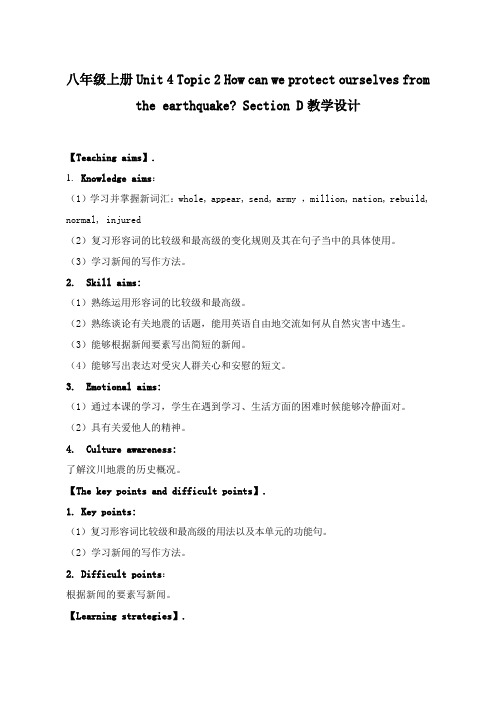
八年级上册Unit 4 Topic 2 How can we protect ourselves from the earthquake? Section D教学设计【Teaching aims】.1.Knowledge aims:(1)学习并掌握新词汇:whole, appear, send, army ,million, nation, rebuild, normal, injured(2)复习形容词的比较级和最高级的变化规则及其在句子当中的具体使用。
(3)学习新闻的写作方法。
2. Skill aims:(1)熟练运用形容词的比较级和最高级。
(2)熟练谈论有关地震的话题,能用英语自由地交流如何从自然灾害中逃生。
(3)能够根据新闻要素写出简短的新闻。
(4)能够写出表达对受灾人群关心和安慰的短文。
3. Emotional aims:(1)通过本课的学习,学生在遇到学习、生活方面的困难时候能够冷静面对。
(2)具有关爱他人的精神。
4. Culture awareness:了解汶川地震的历史概况。
【The key points and difficult points】.1. Key points:(1)复习形容词比较级和最高级的用法以及本单元的功能句。
(2)学习新闻的写作方法。
2. Difficult points:根据新闻的要素写新闻。
【Learning strategies】.1. 善于总结和发现规律,并能学以致用。
2. 在学习中积极与同学合作,共同完成任务。
【Teaching aids】.多媒体课件/图片导学案。
【Teaching procedures】.Step 1:Lead in .Exercise before Class .Daily report and show a picture of Lin hao and Yao ming.Tell the students that Lin hao is shorter than Yao ming. But he is much braver thanYao .Because he was the hero in Wenchuan earthquake . Let’s wacth a video about this little hero and know more about him .(Stimulate the students interest learning.)Step 2:While reading .1.1st reading .Ask the students to read the passage and answer the questions.(1). What happened to his hometown?(2). When did the earthquake happen?(3). How many people died and how many people lost their homes?(4). What’s the meaning of “appear” ?( )A.出来B.出现C.发现D.消失2.2nd reading .Let the students watch a video and complete the table on Page 96. (Aims:1. Provide reading using the target language.2.Get students to practice the reading strategies for getting the specific information and general idea.)Step3 Oral Practice .Ask the students work in group and Talk about the Tangshan earthquake with the help of the following information. Pay attention to the elements in news.(Aims:1.Provide real situation for oral practice, using the target language.2.Provide a better chance for the students to exchange ideas on how to learn English well. 3.Help and learn from one another.)Step4 Writing TaskAsk the students write a piece news about the Tangshan earthquake with the help of the following information. Pay attention to the elements in news.(Aims: Provide reading and writing practice, using the target language to get the students to involve in the “real world” practice actively.)Step5 Summary --- Comparative and superlative degrees of adjectives (Ⅱ)Step6 Test.Step7 Talk about how we can protect ourselves from the earthquake? (You are indoors)( Aims: Provide a chance for the students to know more about how to protect themselves from the earthquake and care for their safety)Step8 Homework.Write a letter to comfort Lin hao .【Blackboard design】.1. Some new words.whole, appear, send, armymillion, nation, rebuild, normal, injured2. Some useful phrases.with the help of, return to normal life, over again3. The factors of a piece of news.Time, Place , Eventparative and superlative degrees of adjectivesterrible ---more terrible ---most terrible【Teaching reflection】.根据新课标初中英语阅读与写作教学的现状,将阅读与写作教学作为一个整体来考虑,将阅读与写作教学中行之有效的各种方法进行优化组合。
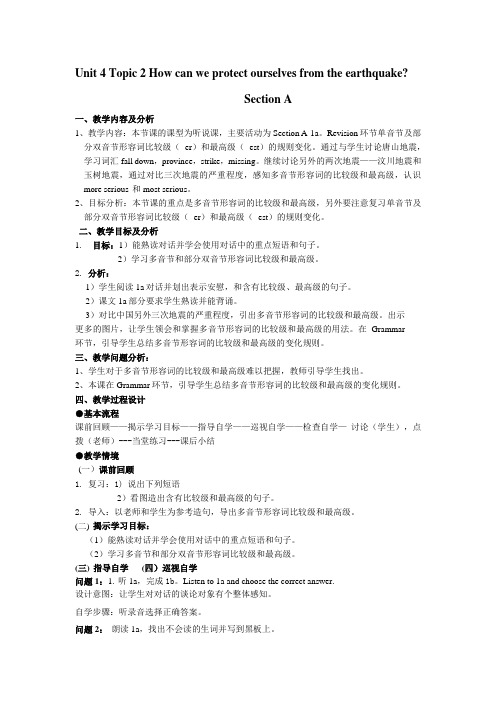
Unit 4 Topic 2 How can we protect ourselves from the earthquake?Section A一、教学内容及分析1、教学内容:本节课的课型为听说课,主要活动为Section A-1a。
Revision环节单音节及部分双音节形容词比较级(- er)和最高级(- est)的规则变化。
通过与学生讨论唐山地震,学习词汇fall down,province,strike,missing。
继续讨论另外的两次地震——汶川地震和玉树地震,通过对比三次地震的严重程度,感知多音节形容词的比较级和最高级,认识more serious 和most serious。
2、目标分析:本节课的重点是多音节形容词的比较级和最高级,另外要注意复习单音节及部分双音节形容词比较级(- er)和最高级(- est)的规则变化。
二、教学目标及分析1.目标:1)能熟读对话并学会使用对话中的重点短语和句子。
2)学习多音节和部分双音节形容词比较级和最高级。
2. 分析:1)学生阅读1a对话并划出表示安慰,和含有比较级、最高级的句子。
2)课文1a部分要求学生熟读并能背诵。
3)对比中国另外三次地震的严重程度,引出多音节形容词的比较级和最高级。
出示更多的图片,让学生领会和掌握多音节形容词的比较级和最高级的用法。
在Grammar环节,引导学生总结多音节形容词的比较级和最高级的变化规则。
三、教学问题分析:1、学生对于多音节形容词的比较级和最高级难以把握,教师引导学生找出。
2、本课在Grammar环节,引导学生总结多音节形容词的比较级和最高级的变化规则。
四、教学过程设计●基本流程课前回顾——揭示学习目标——指导自学——巡视自学——检查自学—讨论(学生),点拨(老师)---当堂练习---课后小结●教学情境(一)课前回顾1. 复习:1) 说出下列短语2)看图造出含有比较级和最高级的句子。
2. 导入:以老师和学生为参考造句,导出多音节形容词比较级和最高级。
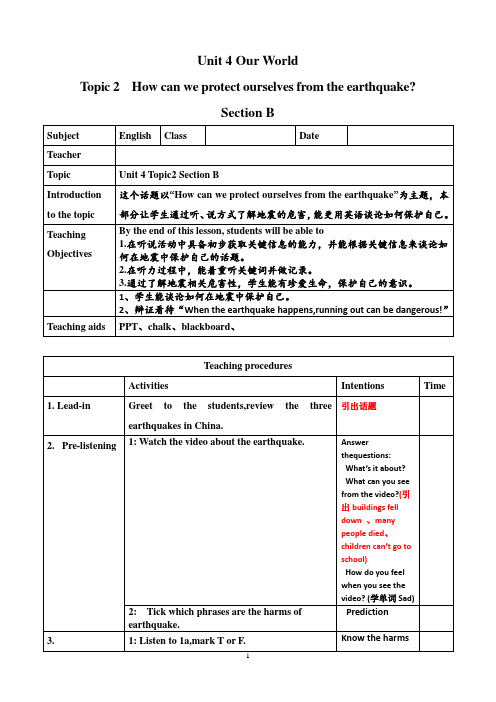
Unit 4topic 2 How can we protect ourselves from the earthquake? Section A一、教学目标1、学习1a,记住重点单词和短语2、能够说出多音节词和部分双音节形容词比较级、最高级的变化形式 .并能熟练做题。
二、教学重难点学生能够正确写出部分双音节形词和多音节形容词的比较等级的变化形式,能熟练做题。
三、教学技能(听、说、读、写)四、教学步骤1、复习形容词的比较级和最高级的构成规律规则变化:(1)一般在形容词词尾加-er或est.如:tall-taller –tallest(2)以字母e结尾的形容词,加r或st.如:late-later-latest(3)以重读闭音节结尾的形容词,词尾只有一辅音字母时,应双写这个辅音字母,再加er 或est.如:big-bigger-biggest.(4)以辅音字母+y 结尾的双音节词,先改y为i,再加er或est.如:happy-happier-happiest.2、呈现(1)earthquake 地震province 省份missing 丢失的Mobile 移动的phone 手机fire 火rainstorm, 暴雨snowstorm 暴风雪(2)protect sb. from 保护……免受……protect sb. from 保护……免受……Wearing sunglasses can ____________________the sunshine.(3)ask sb. for help 向某人求助Eg: 当我们处于危险时,可以向警察求助。
We can _____________________ when we are indanger.(4)And I know that there were another two terrible earthquakes in China. 我知道在中国发生过另外两次严重的地震。
一师一优课教学设计学校:年级:八年级学科:英语课题:Unit4 Topic 2 SectionA授课教师:Unit 4 Our WorldTopic 2 How can we protect ourselves fromthe earthquake?Section AⅠ.Teaching time: 45 minutesⅡ.Class type: new lessonⅢ. Teaching aids: blackboard, video, PPT,tilesⅣ.Teaching aims:1.Learn the new words and phrases: earthquake, province, missing, mobile, phone, lose one’s life, protect sb. from, ask sb. for help ;2.使学生自主发现双多音节形容词比较级、最高级的变化形式,并进行操练,能正确地用形容词的比较级和最高级造句。
3. 能听懂有关报道或谈论地震的消息。
4. 能正确朗读课文,读懂报道地震的消息, 并运用本课所学语言,谈论有关地震的消息。
5. Grammar : the comparative and superlative adjectives: more + adj; the most + adj.6. Know something about the history of Yushu earthquake, Wenchuan earthquake and Tangshan earthquake.7. After learning the earthquake to cherish our lives.Ⅴ.The key points and difficult pointsKey points:1. 学习双多音节形容词的比较级和最高级的变化规则。
2. 学习双多音节形容词的比较级和最高级在句子当中的应用。
八年级上册教案设计Unit 4 Our WorldTopic 2 How can we protect ourselves from the earthquake?Section BⅠ. Material analysis本节课的主要教学活动为1a, 1b和1c。
本节课主要通过Miss Wang和班里的学生之间的谈话引出玉树地震的话题,在对话中了解玉树地震的信息。
简单讲述了如何在地震中逃生的问题以及复习双多音节形容词的比较级和最高级形式。
Ⅱ. Teaching aimsKnowledge aims:1、能根据音标正确朗读出单词表中本课的单词:level, sad, calm, typhoon等。
2、能正确拼读并运用单词表中的黑体单词:level, sad等。
能根据音标正确地书写typhoon, flood 等。
3、能掌握双多音节形容词的比较级和最高级的变化规则,能在具体句子中正确地应用。
4、能正确运用本课所学知识谈论地震的话题,能够用所学知识向受灾的人们给予关爱。
Skill aims:1、能听懂有关谈论地震的话题及用形容词比较级最高级谈论关于灾难的话题。
2、能谈论灾难的情况,并能用所学知识表达自己的关怀。
Emotional aims:1、通过本课学习,了解自然灾害带给人类的危害,学会沉着应对困难。
2、学会关心他人。
Ⅲ. The key points and difficult pointsKey points:1、了解有关地震的知识。
2、通过小组合作学习有关自然灾害的名词。
3、进一步学习双多音节形容词的比较级和最高级的用法。
4、双、多音节形容词的比较级和最高级的熟练使用。
Ⅳ. Learning strategies借助图片和音标记忆单词,可以帮助我们提高学习效率。
Ⅴ. Teaching aidsPPTⅥ. Teaching proceduresStep 1 Introduction (5 minutes)1. Show the teaching goals.2. Get students ready for learning.3. 介绍双音节和多音节形容词的比较级由“more+原级”构成; 最高较级由“most+原级”构成。
八年级英语教学设计课题:Unit 4 Our WorldTopic 2 How can we protect ourselves from the earthquake?Section B一、教材分析本课是仁爱英语(科普版)八年级上Unit 4 Our World 第二个话题。
本课以earthquake为话题,从学生熟悉的地震出发到学习在地震中求生的技巧。
通过Lead-in “Do you know any serious earthquakes in China?”来继续学习形容词的比较等级,掌握形容词比较等级的用法以及本课出现的词组以及固定用法。
1a是Miss Wang 与学生们讨论在地震中如何保护自己,1b是相应的听力练习——判断正误,考察的是学生对课文整体情况的把握。
1c是较1a难的听力练习,属于细节题。
2是拓展听力练习,锻炼学生英语听力,3a是根据音标写单词,注意单词的发音。
3b关于音标/θ/和/ð/的学习以及英语中的连读现象。
4是小组作业,关于自然灾害的看法。
二、学习者分析八年级学生在Topic 1已经接触过形容词的比较等级,已经了解形容词的比较等级的概念以及基本用法,因此在本课只需引入比较级的特殊变化,让学生充分认识和学习形容词的比较等级,以达到灵活运用的目的。
三、教学目标(Teaching Aims and Demands)Teaching aims1.Words and expressions in this topic.2.Target language:--Do you know how to protect ourselves from an earthquake?--I think we should run out of the door.3.掌握形容词的比较等级的用法(Comparative and Superlative Degrees of Adjectives)Language points语言技能目标(1)能对两种事物进行比较,会用形容词进行表达。
仁爱版八年级 Unit4 Topic2 Section CHow to Protect Yourself in the Earthquake?一、教学内容分析:本课选自仁爱英语八年级Unit4 Topic2 SectionC How to Protect Yourself in the Earthquake?,是本话题的一节读写结合课。
本课以阅读的形式介绍了地震自救知识,应用should/shouldn’t来表达应该与不应该。
训练学生的阅读技能,掌握略读和扫读的阅读策略,从阅读材料中获取细节信息的能力,从语境中猜测生词的能力以及给文章解标题的归纳和推理能力,同时在阅读完本课之后,能够向他人传达在火灾中进行自我保护的写作能力。
二、教学目标分析(一)Knowledge aims:1.学习并掌握新词汇:middle, shake, check, downstairs, indoors, doorway, furniture, power, shock, aftershock, gas2.通过阅读学习在地震中自我保护的知识。
(二)Skill aims:1.能在图片或关键词的帮助下读懂介绍自然灾害的文章,以及相应的保护措施。
2.能流利地和他人谈论在自然灾害中如何保护自己。
3.能正确模仿本课课文,有条理地写出在自然灾害中如何保护自己的措施。
(三)Emotional aims:1.在灾害中有自我保护的意识和能力并能沉着应对。
2.在自己的能力范围之内,帮助别人。
三、教学重点、难点分析(一)教学重点:1.学习在地震中如何保护自己的知识。
2.与他人谈论在自然灾害中如何保护自己。
3.能模仿本课所学文章,写一篇火灾自救的文章。
(二)教学难点:在阅读的基础上促进写作,能模仿本课所学文章,写一篇火灾自救的文章四、教学过程设计步骤1:Getting students ready for learningT:Good morning ,boys and girlsSs:Good morning,Miss Wang.T:I’m happy to see you again.Are you ready for the new lesson?Ss:Yes,we are ready.Go,go go!设计意图:简短的师生问候,拉近师生距离,同时为创造一个热情、活跃、和谐的课堂气氛打基础。
并使学生静下心来,让学生快速进入学习状态。
步骤2:Pre-reading1.Lead-in.T:In the last three classes,we have learned something about the earthquake.And today we’ll learn SectionC How to Protect Yourself in the Earthquake?Now I’d like you to check what we should do to protect ourselves based on your own knowledge.Ss:We should protect our head with our arms.T:Good.An earthquake is a kind of very terrible natural disaster. Mostly we can not avoid them, but we can try to protect ourselves. Have you found more information about how to protect yourselves from an earthquake?Ss:。
设计意图:引入本节课话题——地震自救,利用经验预测课文内容,引导学生思考如何在地震中保护自己,让学生们各抒己见,为学习新课文做好铺垫。
2.DiscussionT:I agree with you. The safest place is under a strong table or a desk. Look at these two pictures.doorway (板书“出入口,门道”)middle(板书“中间,中央”)T:Do you think where is safer indoors, in the doorway or in the middle of the room when an earthquake happens?S1: I think we should sit on the floor in the doorway.T: I think so. Sitting on the floor in the doorway is safer than standing in the middle of the room. Look at the picture, it is furniture(板书“家具”).T:Do you think whether it is safe to stay near the tall furniture?S2: I don’t think so. It may fall down and hurt us.T:If you try to go out, can you take a lift to go downstairs?S3: No.T: Yes. In fact, you shouldn’t try to go out of the building. It’s more dangerous. Anyway, I think keeping calm is the most important.设计意图:在讨论的过程中采用不同的方式呈现和学习新词汇,既学习了新词语,有能在口语中运用这些词语,同时也可以引导学生进行思维的碰撞——地震自救常识。
解决1a文本中的生词,帮助学生扫清语言障碍,同时构建学生的语言知识。
步骤3:While-reading1.SkimmingT: We’ll read a passage about how to protect ourselves in the earthquake. Skim it and find the main idea of each paragraph. Or you may underline the topic sentence of each paragraph. Ss:Paragraph1:Knowing some ways to protect yourself will help to keep you safe in the earthquake.Paragraph2:How to protect ourselves if we are indoors when an earthquake happens.Paragraph3:How to protect ourselves if we are outdoors.Paragraph4:The danger is not over when the strong shaking stops.Paragraph5:Try to help others and stay calm.设计意图:通过层层提问,引导学生运用略读策略阅读文本,学生对本文有了大概了解,厘清结构,突显脉络。
要求学生把每段主题句画出来,向学生提供关键性支架,为后续的输出做准备。
阅读技巧引导:通过略读策略抓文章主旨大意,段落主题句一般位于段首,有时也位于段中或段尾2.Scanning【任务一】Finish 1bT: The pictures in 1b are about how to protect ourselves indoors and outdoors in the earthquake. Now let’s read the passage carefully and write down the key words under each picture.【任务二】Finish 1cT:Ok.let’s deal with the key points and difficult sentences of the passage.Please finish 1c in your group .设计意图:通过任务型教学法,引导学生运用寻读策略阅读文本,训练学生借助1b图片理解关于地震中自我保护的锻炼,同时训练学生自我保护意识和关爱让人的精神。
完成1c后,学生对文章的细节有更进一步的了解。
阅读技巧引导:寻读策略是为了查特定信息,寻找细节,忽略整体。
3.Key points(1)keep sb. / sth. + adj.保持 / 护某人 / 物……(2)close to 靠近 / 接近(介词短语)(3)stay away from = get away from远离……(4)be over结束步骤4:Post-reading1.RetellLead the students to retell the passage according to the pictures and the key words in 1b.设计意图:通过之前的阅读训练,已经引导学生学习本课的语篇结构知识。
再通过复述这个环节,学生们能进一步运用语言。
为了降低难度,给学生提供如图所示的提纲。
为下一步学生模仿地震自救课文进行类似话题的写作,即仿写,做到以读促写,以写带读。
2.Group work【任务一】Finish 2aT: As we all know, we may encounter some emergencies in our life. We can’t avoid all of them. So it is very important for us to know some ways to protect ourselves in sudden disasters such as earthquakes and fires. Do you know what you should and shouldn’t do in a fire? Look at the pictures in 2a and match the phrases with them.【任务二】Finish 2bT: When we give s uggestions, we often say “ you should…” or “you shouldn’t …”. But in fact, we can use more useful expressions to express the same ideas. Can you think of more structures?设计意图:2a在于通过图文匹配和小组讨论,激活学生的思维,是学生在交流、合作中发现问题,思考问题和解决问题,并为写作提供观点。